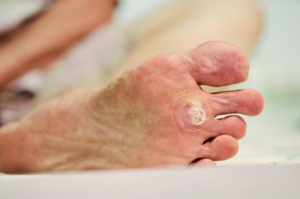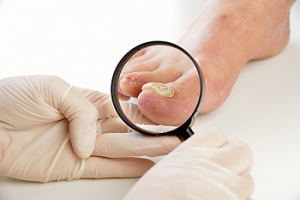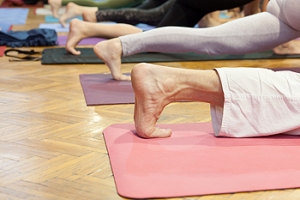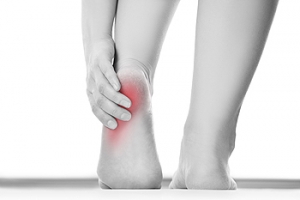Super User
What Does A Plantar Wart Look Like?
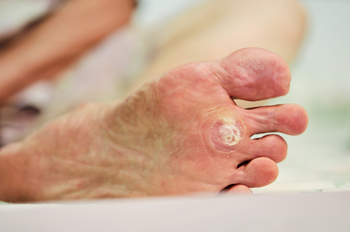 Common warts are caused by the human papillomavirus, which is known as HPV. The top layer of the skin becomes thickened and grows outward and will typically appear as a small bump. A plantar wart also originates from the same virus, and the exception is that it grows inward on the heel of the foot. This is typically a result of the pressure the heels endure from consistent walking and standing for the majority of the day. This condition is commonly accompanied by severe pain and discomfort. Therefore, walking may be difficult. It may appear as a hardened area on the heel of the foot, and may have small blood vessels in the center, which appear as tiny black dots. If you feel you have a plantar wart, it’s advised to speak to a podiatrist as quickly as possible, so proper treatment techniques can commence.
Common warts are caused by the human papillomavirus, which is known as HPV. The top layer of the skin becomes thickened and grows outward and will typically appear as a small bump. A plantar wart also originates from the same virus, and the exception is that it grows inward on the heel of the foot. This is typically a result of the pressure the heels endure from consistent walking and standing for the majority of the day. This condition is commonly accompanied by severe pain and discomfort. Therefore, walking may be difficult. It may appear as a hardened area on the heel of the foot, and may have small blood vessels in the center, which appear as tiny black dots. If you feel you have a plantar wart, it’s advised to speak to a podiatrist as quickly as possible, so proper treatment techniques can commence.
Plantar warts can be very uncomfortable. If you need your feet checked, contact one of our podiatrists from Westside Podiatry Center, LLP. Our doctors will assist you with all of your foot and ankle needs.
About Plantar Warts
Plantar warts are the result of HPV, or human papillomavirus, getting into open wounds on the feet. They are mostly found on the heels or balls of the feet.
While plantar warts are generally harmless, those experiencing excessive pain or those suffering from diabetes or a compromised immune system require immediate medical care. Plantar warts are easily diagnosed, usually through scraping off a bit of rough skin or by getting a biopsy.
Symptoms
- Lesions on the bottom of your feet, usually rough and grainy
- Hard or thick callused spots
- Wart seeds, which are small clotted blood vessels that look like little black spots
- Pain, discomfort, or tenderness of your feet when walking or standing
Treatment
- Freezing
- Electric tool removal
- Laser Treatment
- Topical Creams (prescription only)
- Over-the-counter medications
To help prevent developing plantar warts, avoid walking barefoot over abrasive surfaces that can cause cuts or wounds for HPV to get into. Avoiding direct contact with other warts, as well as not picking or rubbing existing warts, can help prevent the further spread of plantar warts. However, if you think you have developed plantar warts, speak to your podiatrist. He or she can diagnose the warts on your feet and recommend the appropriate treatment options.
If you have any questions please feel free to contact one of our offices located in Liverpool, Camillus, Skaneateles, Oswego, and Cicero, NY . We offer the newest diagnostic and treatment technologies for all your foot and ankle needs.
What Are Plantar Warts?
Plantar warts are described as small growths that appear on the heels or other areas of the feet that bear a large amount of weight. The pressure in these areas causes plantar warts to hide behind thick layers of skin called calluses. In most cases, plantar warts are not a serious health issue, and they usually go away without treatment. However, it is still important be mindful of them.
Plantar warts are caused by infections with human papillomavirus (HPV) in the outer layer of skin on the soles of the feet. The plantar warts then develop when the virus enters the body through weak spots at the bottom of the feet, such as tiny cuts and breaks. Plantar warts are not guaranteed for all who encounter the virus. Everyone responds differently to the affects of HPV.
Plantar warts are most common in the following groups: children and teenagers, people with weakened immune systems, people with history of plantar warts, and people who walk barefoot. Exposure to HPV is common in environments such as locker rooms or pool areas.
One of early signs to look out for is a callus, since many plantar warts hide behind them. You can also locate these warts by looking for small, fleshy, rough, grainy growths near the base of the toes and the heel. Early signs of plantar warts are shown by black pinpoints, which are small, clotted blood vessels. Lesions that interrupt normal lines and ridges in the skin of your foot may also be a sign of plantar warts. Any feeling of pain while walking or standing can also be a symptom of plantar warts.
Although most cases are not serious, some conditions may require a visit to your podiatrist. If you are uncertain that your lesion is a wart, if you have diabetes, or if you are experiencing bleeding, you may need to see a seek professional treatment. Your doctor may offer treatments such as prescribing stronger peeling medicine or using cryotherapy by applying liquid nitrogen to the wart. More serious cases may require minor surgery or laser treatment.
There are simple solutions available to help prevent plantar warts. One common task is to avoid walking barefoot in swimming pool areas and locker rooms, as this is where HPV is commonly present. Keeping your feet clean and dry, while changing shoes and socks daily can also help prevent future plantar warts. If you know someone who has plantar warts, it is important to avoid direct contact with their warts. You should also refrain from picking or scratching your wart if you happen to develop one.
Symptoms of Sever’s Disease
 The condition that is referred to as Sever’s disease will typically affect young teenagers. Noticeable symptoms may include inflammation and swelling in the heel, and this may be a result of an injury that may have occurred to the growth plate. Patients who are afflicted with this condition may notice they are walking on tip toes or limping, and their feet may feel stiff when they are waking up. It typically affects older children who frequently participate in sporting activities. This may cause the tendons and muscles to tighten, and pressure may be put on the growth plate. Mild relief may be found if the activities are stopped that may have caused this condition. Additionally, some patients find it helpful to wear shoes that have an open back, or to wrap the heel with an elastic bandage. If you think your child may have Sever’s disease, it is advised to consult with a podiatrist who can properly treat this condition.
The condition that is referred to as Sever’s disease will typically affect young teenagers. Noticeable symptoms may include inflammation and swelling in the heel, and this may be a result of an injury that may have occurred to the growth plate. Patients who are afflicted with this condition may notice they are walking on tip toes or limping, and their feet may feel stiff when they are waking up. It typically affects older children who frequently participate in sporting activities. This may cause the tendons and muscles to tighten, and pressure may be put on the growth plate. Mild relief may be found if the activities are stopped that may have caused this condition. Additionally, some patients find it helpful to wear shoes that have an open back, or to wrap the heel with an elastic bandage. If you think your child may have Sever’s disease, it is advised to consult with a podiatrist who can properly treat this condition.
Sever's disease often occurs in children and teens. If your child is experiencing foot or ankle pain, see one of our podiatrists from Westside Podiatry Center, LLP. Our doctors can treat your child’s foot and ankle needs.
Sever’s Disease
Sever’s disease is also known as calcaneal apophysitis, which is a medical condition that causes heel pain I none or both feet. The disease is known to affect children between the ages of 8 and 14.
Sever’s disease occurs when part of the child’s heel known as the growth plate (calcaneal epiphysis) is attached to the Achilles tendon. This area can suffer injury when the muscles and tendons of the growing foot do not keep pace with bone growth. Therefore, the constant pain which one experiences at the back of the heel will make the child unable to put any weight on the heel. The child is then forced to walk on their toes.
Symptoms
Acute pain – Pain associated with Sever’s disease is usually felt in the heel when the child engages in physical activity such as walking, jumping and or running.
Highly active – Children who are very active are among the most susceptible in experiencing Sever’s disease, because of the stress and tension placed on their feet.
If you have any questions, please feel free to contact one of our offices located in Liverpool, Camillus, Skaneateles, Oswego, and Cicero, NY . We offer the newest diagnostic and treatment technologies for all your foot and ankle injuries.
Sever's Disease
Sever’s disease, also known as calcaneal apophysitis is a common bone disorder that occurs during childhood. The disease is defined as an inflammation of the growth plate in the heel. When a child has a growth spurt, his heel bone grows faster than the muscles, tendons, and ligaments in his leg. This disease is a result of overuse. The people who are most likely to be affected by this disease are children who are in a growth spurt, especially boys who are from the ages of 5 to 13 years old. 60% of children with Sever’s disease have both heels involved.
Symptoms of this disease are heel pain that intensifies during running and jumping activities. The pain is typically localized to the posterior part of the heel. Symptoms may be severe, and they can easily interfere with daily activities. Children who play soccer, baseball, and basketball are more likely to develop Sever’s disease.
Your doctor will diagnose your child based on his or her symptoms, x-rays are generally not helpful in diagnosing this disease. Your doctor may examine both heels and ask your child questions about his or her activity level in sports. Your doctor may then use the squeeze test on your child’s heel to see if there is any pain. Nevertheless, some doctors might still use x-rays to rule out any other issues such as fractures, infections, and tumors.
Sever’s disease can be prevented by maintaining good flexibility while your child is growing. Another prevention method is to wear good-quality shoes that have firm support and a shock-absorbent sole. Sever’s disease can be treated by ceasing any activity that causes heel pain. You should apply ice to the injured heel for 20 minutes 3 times a day. Additionally, orthotics should be used for children who have high arches, flat feet, or bowed legs.
If you suspect your child has Sever’s disease, you should make an appointment with your podiatrist to have his or her foot examined. Your doctor may recommend nonsteroidal anti-inflammatory drugs (NSAIDs), such as ibuprofen or naproxen to relieve pain. In more severe cases, your child may need a cast to rest his or her heel. Fortunately, Sever’s disease does not cause long-term foot problems. After treatment, your child should start to feel better within two weeks to two months.
Is Toenail Fungus Contagious?
 If you notice your toenails becoming thick and turning a yellowish shade, you may have what is referred to as toenail fungus. Research has shown this fungus may attack nails that have incurred damage, which may have been the result of a weakened immune system, in addition to patients who have diabetes or poor circulation. The symptoms in severe cases of toenails fungus may include pain that is felt in the nail area when shoes are worn, extreme cracks in the skin or an itching feeling in the area surrounding the toenail. This type of fungus is contagious, and it thrives in warm and moist areas that typically include public pools, communal showers, or locker rooms. If you are frequently in these types of places, it is suggested to wear appropriate shoes, which may aid in the prevention of toenail fungus. If you feel you may have this unsightly condition, it is advised to consult with a podiatrist who can offer proper treatment options.
If you notice your toenails becoming thick and turning a yellowish shade, you may have what is referred to as toenail fungus. Research has shown this fungus may attack nails that have incurred damage, which may have been the result of a weakened immune system, in addition to patients who have diabetes or poor circulation. The symptoms in severe cases of toenails fungus may include pain that is felt in the nail area when shoes are worn, extreme cracks in the skin or an itching feeling in the area surrounding the toenail. This type of fungus is contagious, and it thrives in warm and moist areas that typically include public pools, communal showers, or locker rooms. If you are frequently in these types of places, it is suggested to wear appropriate shoes, which may aid in the prevention of toenail fungus. If you feel you may have this unsightly condition, it is advised to consult with a podiatrist who can offer proper treatment options.
If left untreated, toenail fungus may spread to other toenails, skin, or even fingernails. If you suspect you have toenail fungus it is important to seek treatment right away. For more information about treatment, contact one of our podiatrists of Westside Podiatry Center, LLP. Our doctors can provide the care you need to keep you pain-free and on your feet.
Symptoms
- Warped or oddly shaped nails
- Yellowish nails
- Loose/separated nail
- Buildup of bits and pieces of nail fragments under the nail
- Brittle, broken, thickened nail
Treatment
If self-care strategies and over-the-counter medications does not help your fungus, your podiatrist may give you a prescription drug instead. Even if you find relief from your toenail fungus symptoms, you may experience a repeat infection in the future.
Prevention
In order to prevent getting toenail fungus in the future, you should always make sure to wash your feet with soap and water. After washing, it is important to dry your feet thoroughly especially in between the toes. When trimming your toenails, be sure to trim straight across instead of in a rounded shape. It is crucial not to cover up discolored nails with nail polish because that will prevent your nail from being able to “breathe”.
In some cases, surgical procedure may be needed to remove the toenail fungus. Consult with your podiatrist about the best treatment options for your case of toenail fungus.
If you have any questions, please feel free to contact one of our offices located in Liverpool, Camillus, Skaneateles, Oswego, and Cicero, NY . We offer the newest diagnostic and treatment technologies for all your foot care needs.
Treating Toenail Fungus
Fungal infection of the toenail, or onychomycosis, typically appears as a gradual change in a toenail’s texture and color that involves brittleness and darkening. The fungal infection itself occurs beneath the surface of the nail. Aside from discoloration, other symptoms include the collection of debris beneath the nail plate, white marks on the nail plate, and a foul odor emanating from the nail. If ignored, the infection can spread into other nails and the skin; in severe cases, it can hinder one’s ability to work or walk.
The toenails are particularly vulnerable to contracting infection in moist environments where people are likely to be walking barefoot, such as around swimming pools, public showers, and locker rooms. Fungal infection may also be more likely to occur in nail beds that have been injured, and sufferers of chronic diseases such as diabetes, circulatory problems, or immunodeficiency conditions are particularly prone to developing fungal nails.
Fungal nails can be primarily prevented by practicing proper hygiene and regularly examining the feet and toes. Carefully washing the feet with soap and water and thoroughly drying the feet afterwards are essential. Other tips include wearing shower shoes in public areas, changing shoes and socks daily, keeping toenails clipped at a short length, wearing breathable shoes that fit properly, wearing moisture-wicking socks, and disinfecting home pedicure tools and instruments used to cut nails.
Fungal nail treatment may vary between patients and the severity of the condition. Your podiatrist may suggest a daily routine of cleansing that spans over a period of time to ease mild infections. Over-the-counter or prescription antifungal agents may also be prescribed, including topical and/or oral medications. Debridement, or the removal of diseased nail matter and debris, may also be performed. In more severe cases, surgical treatment may be needed. In some instances, the temporary removal of the fungal nail allows for the direct application of a topical antifungal to the nail bed. In other cases, a chronically painful fungal nail that has not responded to other treatments may be permanently removed; this allows the infection to be cured and avoids the growth of a deformed nail.
Performing Yoga Poses May Be Effective in Stretching the Feet
 Many people enjoy the practice of yoga to achieve more than adequate stretches in their feet. When the proper stretches are performed, they may aid in keeping the feet strong. If a fall should occur, having strong feet may help in preventing painful ankle sprains or fractures. The feet endure the weight of the body for most of the day, and it’s important to understand that proper stretching may keep the feet flexible and supple. An effective stretch that may open the ankles, toes and plantar fascia is to kneel while sitting on your heels and keeping the toes tucked under. There are several other efficient poses, which may include threading your fingers between your toes and holding this position for a few minutes. This may help to loosen that arch of the foot. Additionally, performing the downward dog yoga pose will benefit the Achilles tendon, toes, and foot muscles. Balancing the body on the toes is effective in building strength and flexibility, even though it may feel uncomfortable at first. If you would like additional information about the benefits of stretching the feet, please consult with a podiatrist.
Many people enjoy the practice of yoga to achieve more than adequate stretches in their feet. When the proper stretches are performed, they may aid in keeping the feet strong. If a fall should occur, having strong feet may help in preventing painful ankle sprains or fractures. The feet endure the weight of the body for most of the day, and it’s important to understand that proper stretching may keep the feet flexible and supple. An effective stretch that may open the ankles, toes and plantar fascia is to kneel while sitting on your heels and keeping the toes tucked under. There are several other efficient poses, which may include threading your fingers between your toes and holding this position for a few minutes. This may help to loosen that arch of the foot. Additionally, performing the downward dog yoga pose will benefit the Achilles tendon, toes, and foot muscles. Balancing the body on the toes is effective in building strength and flexibility, even though it may feel uncomfortable at first. If you would like additional information about the benefits of stretching the feet, please consult with a podiatrist.
Stretching the feet is a great way to prevent injuries. If you have any concerns with your feet consult with one of our podiatrists from Westside Podiatry Center, LLP. Our doctors will assess your condition and provide you with quality foot and ankle treatment.
Stretching the Feet
Stretching the muscles in the foot is an important part in any physical activity. Feet that are tight can lead to less flexibility and make you more prone to injury. One of the most common forms of foot pain, plantar fasciitis, can be stretched out to help ease the pain. Stretching can not only ease pain from plantar fasciitis but also prevent it as well. However, it is important to see a podiatrist first if stretching is right for you. Podiatrists can also recommend other ways to stretch your feet. Once you know whether stretching is right for you, here are some excellent stretches you can do.
- Using a foam roller or any cylindrical object (a water bottle or soda can will do), roll the object under your foot back and forth. You should also exert pressure on the object. Be sure to do this to both feet for a minute. Do this exercise three times each.
- Similar to the previous one, take a ball, such as a tennis ball, and roll it under your foot while seated and exert pressure on it.
- Grab a resistance band or towel and take a seat. If you are using a towel, fold it length wise. Next put either one between the ball of your foot and heel and pull with both hands on each side towards you. Hold this for 15 seconds and then switch feet. Do this three times for each foot.
- Finally hold your big toe while crossing one leg over the other. Pull the toe towards you and hold for 15 seconds. Once again do this three times per foot.
It is best to go easy when first stretching your foot and work your way up. If your foot starts hurting, stop exercising and ice and rest the foot. It is advised to then see a podiatrist for help.
If you have any questions, please feel free to contact one of our offices located in Liverpool, Camillus, Skaneateles, Oswego, and Cicero, NY . We offer the newest diagnostic and treatment technologies for all your foot care needs.
How to Stretch Your Feet
Your feet endure a great amount of stress each day from constantly allowing us to move around. It is important to stretch your feet to help prevent them from becoming injured. Your toes may easily deform into unhealthful positions if they are not stretched.
One of the most common reasons for toe deformities are the shoes you may be wearing. Shoes that are too tight may fold and shift the toes out of place. Heeled shoes may also push your toes upward. Forcing your toes into an unnatural position which may cause the muscles to tighten and prevent them from reverting to normal length. Another common reason is improper use of foot muscles. Many people fail to use the muscles in their feet or toes when they walk. Lastly, the positioning of your feet while walking may also cause toe deformities. If you walk with your feet facing outward, your “push-off” phase is on the side of your big toe instead of the bottom of your foot. This may cause the big toe to eventually tighten into a new shifted position.
There are many reasons why stretching your toes may be helpful. One reason is that healthy spacing may aid in avoiding calluses and other injuries that are caused by rubbing. Stretching will also prevent you from developing toes that curl, hammertoes, or bunions.
A great way to stretch your toes is to place them in your hands and bend them all downward; this will help you stretch the top of your foot. Next, you should repeat this process but instead bend them upward enough to feel a nice stretch in the bottom of your foot. You should then try to pull each toe apart from the next and pull any toes that are bent upward until they are back downward.
If you are looking to practice stretching your entire foot, you can try a towel stretch. This is done by sitting on the floor with your legs in front of you. Take a towel and wrap it around your toes. Afterward, pull the towel toward you with your toes and hold this position for 15 to 30 seconds before releasing. Practice this stretch for three sets. Another stretch your feet are towel lifts. This is done by sitting in a chair and trying to pick a towel up from the ground with your toes. Try lifting the towel with your little toes for five sets before switching feet.
If you are an athlete, or exercise often, it is especially important for you to practice stretching your feet. Those who suffer from foot pain caused by poor footwear, plantar fasciitis, or long hours of standing at work may also benefit from foot exercises.
Types and Causes of Heel Pain
 The heel of the foot is sometimes referred to as the “hindfoot", and consists of various types of tissues. If damage should occur to these group of tissues, the result may be heel pain. Research has indicated there are several kinds of heel pain, including plantar fasciitis, Achilles tendonitis, and nerve disorders. The former will often cause pain that is typically worse as the first steps are taken in the morning and may improve if proper foot stretches are performed. The Achilles tendon connects the calf muscles to the heel. If this should become torn as a result of an injury, Achilles tendonitis will develop. This is often treated with physical therapy, or by wearing orthotics. It is common for many diabetic patients to experience nerve disorders, and heel pain can develop as a result of having peripheral neuropathy. If you have any type of heel pain, it is suggested to counsel with a podiatrist who can perform a proper diagnosis and begin correct treatment techniques.
The heel of the foot is sometimes referred to as the “hindfoot", and consists of various types of tissues. If damage should occur to these group of tissues, the result may be heel pain. Research has indicated there are several kinds of heel pain, including plantar fasciitis, Achilles tendonitis, and nerve disorders. The former will often cause pain that is typically worse as the first steps are taken in the morning and may improve if proper foot stretches are performed. The Achilles tendon connects the calf muscles to the heel. If this should become torn as a result of an injury, Achilles tendonitis will develop. This is often treated with physical therapy, or by wearing orthotics. It is common for many diabetic patients to experience nerve disorders, and heel pain can develop as a result of having peripheral neuropathy. If you have any type of heel pain, it is suggested to counsel with a podiatrist who can perform a proper diagnosis and begin correct treatment techniques.
Many people suffer from bouts of heel pain. For more information, contact one of our podiatrists of Westside Podiatry Center, LLP. Our doctors can provide the care you need to keep you pain-free and on your feet.
Causes of Heel Pain
Heel pain is often associated with plantar fasciitis. The plantar fascia is a band of tissues that extends along the bottom of the foot. A rip or tear in this ligament can cause inflammation of the tissue.
Achilles tendonitis is another cause of heel pain. Inflammation of the Achilles tendon will cause pain from fractures and muscle tearing. Lack of flexibility is also another symptom.
Heel spurs are another cause of pain. When the tissues of the plantar fascia undergo a great deal of stress, it can lead to ligament separation from the heel bone, causing heel spurs.
Why Might Heel Pain Occur?
- Wearing ill-fitting shoes
- Wearing non-supportive shoes
- Weight change
- Excessive running
Treatments
Heel pain should be treated as soon as possible for immediate results. Keeping your feet in a stress-free environment will help. If you suffer from Achilles tendonitis or plantar fasciitis, applying ice will reduce the swelling. Stretching before an exercise like running will help the muscles. Using all these tips will help make heel pain a condition of the past.
If you have any questions please contact one of our offices located in Liverpool, Camillus, Skaneateles, Oswego, and Cicero, NY . We offer the newest diagnostic and treatment technologies for all your foot and ankle needs.
Heel Pain
Heel pain can be difficult to deal with, especially if you do not know what the underlying cause is. If you ignore your heel pain, the pain can magnify and potentially develop into a chronic condition. Depending on the location of your heel pain, you have developed a specific condition.
One condition is plantar fasciitis. Plantar fasciitis is caused by the inflammation of the plantar fascia, or the band of tissue that connects the heel bone to the base of the toes. The pain from this condition is initially mild but can intensify as more steps are taken when you wake up in the morning. To treat this condition, medication will likely be necessary. Plantar fasciitis is often associated with heel spurs; both require rest and special stretching exercises.
There are various options your podiatrist may suggest for heel pain. Treatment options for heel pain typically include non-steroidal anti-inflammatory drugs (NSAIDS), which may reduce swelling and pain. Other options are physical therapy, athletic taping, and orthotics. In severe cases of heel pain, surgery may be required.
Preventing heel pain is possible. If you are looking to prevent heel pain from developing in the future, be sure to wear shoes that fit you properly and do not have worn down heels or soles. Be sure to warm up properly before participating in strenuous activities or sports that place a lot of a stress on the heels. If you are experiencing any form of heel pain, speak with your podiatrist to determine the underlying cause and receive the treatment you need.
